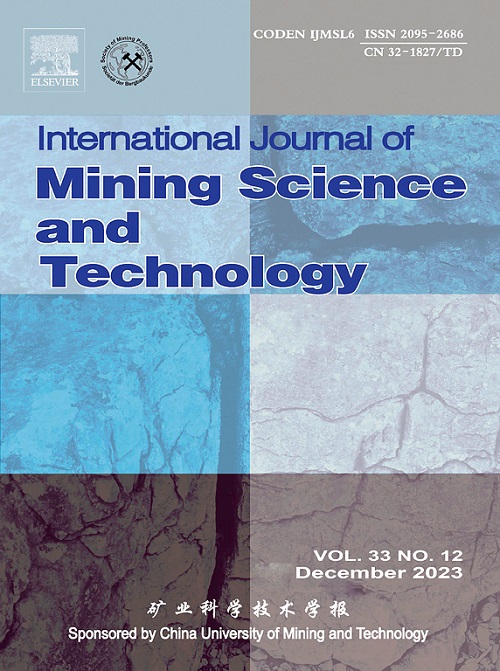内循环气体压力加载下盐岩变形的新粘塑性模型
IF 13.7
1区 工程技术
Q1 MINING & MINERAL PROCESSING
International Journal of Mining Science and Technology
Pub Date : 2025-06-01
DOI:10.1016/j.ijmst.2025.05.005
引用次数: 0
摘要
盐穴被广泛用于储能。在储气过程中,内部气体压力随能源需求周期性波动,因此评估这些压力变化对岩石变形的影响至关重要。在本研究中,我们在不同的循环气体压力条件下进行了实验来研究这种影响。结果表明:(1)盐岩变形过程可划分为减速阶段、稳态阶段和加速阶段3个阶段;(2)当轴向压力一定时,轴向和径向变形随循环气体压力的变化均呈逐步增大的趋势。同样,在轴向梯度加载下,变形也表现出渐进的上升趋势。通过分析单个气体压力循环内的变形差异和模型系数波动,发现径向变形对循环气体压力的变化更为敏感。(3)轴向变形随气体压力的变化呈逐步增大的趋势,径向变形随气体压力的变化呈循环变化。因此,引入循环气体压力影响因子α、轴向载荷影响因子β和状态变量σ *,建立了考虑循环气体压力、围压和轴向应力影响的粘塑性本体论模型。经变形数据验证,新模型能较好地拟合三个阶段的轴向变形和径向变形,只需改变较少的参数,具有较强的适用性和准确性。状态变化率与盐岩的变形速率和残余应变表现出相同的阶段,能较好地反映盐岩的内部硬化。本文章由计算机程序翻译,如有差异,请以英文原文为准。
A novel viscoplastic model for salt rock deformation under internal cyclic gas pressure loading
Salt caverns are widely used for energy storage. During gas storage, the internal gas pressure fluctuates cyclically in response to energy demand, making it essential to assess how these pressure variations affect rock deformation. In this study, experiments were conducted under different cyclic gas pressure conditions to investigate this effect. The findings indicate that (1) the deformation process of salt rock can be segmented into three stages: the deceleration stage, the steady-state stage, and the acceleration stage. (2) When the axial pressure remains constant, both axial and radial deformations exhibit a stepwise increasing trend in response to cyclic gas pressure variations. Similarly, under axial graded loading, the deformations also demonstrate a progressive rise. By analyzing the deformation differences and model coefficient fluctuations within a single gas pressure cycle, it is found that radial deformation is higher sensitive to changes in cyclic gas pressure. (3) The axial deformation shows a stepwise increase, and the radial deformation showed a cyclic change with changing gas pressure. Therefore, the cyclic gas pressure influence factor , axial loading influence factor , and state variable are introduced to develop a viscoplastic ontological model that accounts for the impacts of cyclic gas pressure, confining pressure and axial stress. Validated by the deformation data, the new model can better fit both the axial deformation and the radial deformation of the three stages and has strong applicability and accuracy by changing only fewer parameters. The state variable rate shows the same stage as the deformation rate and residual strain of salt rock, which can better reflect the internal hardening of salt rock.
求助全文
通过发布文献求助,成功后即可免费获取论文全文。
去求助
来源期刊

International Journal of Mining Science and Technology
Earth and Planetary Sciences-Geotechnical Engineering and Engineering Geology
CiteScore
19.10
自引率
11.90%
发文量
2541
审稿时长
44 days
期刊介绍:
The International Journal of Mining Science and Technology, founded in 1990 as the Journal of China University of Mining and Technology, is a monthly English-language journal. It publishes original research papers and high-quality reviews that explore the latest advancements in theories, methodologies, and applications within the realm of mining sciences and technologies. The journal serves as an international exchange forum for readers and authors worldwide involved in mining sciences and technologies. All papers undergo a peer-review process and meticulous editing by specialists and authorities, with the entire submission-to-publication process conducted electronically.
 求助内容:
求助内容: 应助结果提醒方式:
应助结果提醒方式:


